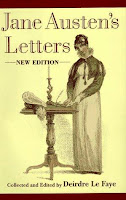Reading the Classics: Review of T.H. White's "Letters to a Friend" and Jane Austen's "Complete Letters Collection"
An epistolary novel, for those who are unaware of the term, is a novel written as a series of documents, usually through diary entries. Although the aforementioned titles are not fictional, they do read as though they could have been. Epistolary novels such as The History of Sir Charles Grandison, Clarissa, and Pamela were amongst Jane's favourites, and she even wrote one of her first books, Lady Susan, in the same style. Though T.H. White did not publish any epistolary work, he certainly read a great deal of it, as he had to do for his book The Age of Scandal, and subsequently fell in love with the time period during which this style of novel was most prevalent.
Jane's letters, comprised of daily accounts directed to her sister Cassandra, her publisher Mr Barry, her niece Fanny Knight, her best friend Martha Lloyd, and her friend Jame Stanley Clarke, detail everything about her world but little about her personal sentiments. Cassandra, to keep her sister's private life from reaching the public eye, burned a good portion of her letters that detailed her relationships with Lefroy, Biggs, Bridges, and possibly Blackall, who may or may not have been her influences for Willoughby, Darcy, Edmund Bertram, Henry Tilney, respectively. Because of Cassandra's careful selection, Jane's letters outline family meeting, boast of good dinners, and discuss Jane's life in general from the time of her leaving Bath until her death. There are many memorable letters to enjoy, such as the one that details Jane's interest in a sponge cake, the operation of her hat, and her advice on dating to her young niece, but it is rather unfortunate that we will never know her greatest distresses and her most passionate loves.
T.H. White's letters, however, are the complete opposite to Jane's correspondences. In Letters to a Friend, Tim writes to his mentors and confidantes L.J. and Mary Potts. L.J. Potts was Tim's mentor during his time in Cambridge, and though the two men were only nine years apart, Tim looked up to Potts as Arthur looks up to Merlyn in Once and Future King. He told Potts everything about his poverty, his difficulties with his family, his incredible loneliness, his struggles with employment, his frustrations with the publishing industry, his terror of war, his fear for humanity and where we as a race might be headed. Tim also displays the prowess of his active fancy through his drawings, his paintings, his learning to play musical instruments much to the chagrin of his neighbors. He details his life as an eccentric recluse in the country and does it with all the self deprecating false complacence that his cleverness allows.
Where a biography might read with all the powers a dirge can excite, neither one of these books pines or laments for an instant. They are ingenuous, feeling, hilarious, and essential to anyone reader who wants to know more about these authors without all the bias and boredom a biographer could warrant.
Jane's letters, comprised of daily accounts directed to her sister Cassandra, her publisher Mr Barry, her niece Fanny Knight, her best friend Martha Lloyd, and her friend Jame Stanley Clarke, detail everything about her world but little about her personal sentiments. Cassandra, to keep her sister's private life from reaching the public eye, burned a good portion of her letters that detailed her relationships with Lefroy, Biggs, Bridges, and possibly Blackall, who may or may not have been her influences for Willoughby, Darcy, Edmund Bertram, Henry Tilney, respectively. Because of Cassandra's careful selection, Jane's letters outline family meeting, boast of good dinners, and discuss Jane's life in general from the time of her leaving Bath until her death. There are many memorable letters to enjoy, such as the one that details Jane's interest in a sponge cake, the operation of her hat, and her advice on dating to her young niece, but it is rather unfortunate that we will never know her greatest distresses and her most passionate loves.
T.H. White's letters, however, are the complete opposite to Jane's correspondences. In Letters to a Friend, Tim writes to his mentors and confidantes L.J. and Mary Potts. L.J. Potts was Tim's mentor during his time in Cambridge, and though the two men were only nine years apart, Tim looked up to Potts as Arthur looks up to Merlyn in Once and Future King. He told Potts everything about his poverty, his difficulties with his family, his incredible loneliness, his struggles with employment, his frustrations with the publishing industry, his terror of war, his fear for humanity and where we as a race might be headed. Tim also displays the prowess of his active fancy through his drawings, his paintings, his learning to play musical instruments much to the chagrin of his neighbors. He details his life as an eccentric recluse in the country and does it with all the self deprecating false complacence that his cleverness allows.
Where a biography might read with all the powers a dirge can excite, neither one of these books pines or laments for an instant. They are ingenuous, feeling, hilarious, and essential to anyone reader who wants to know more about these authors without all the bias and boredom a biographer could warrant.



Comments
Post a Comment